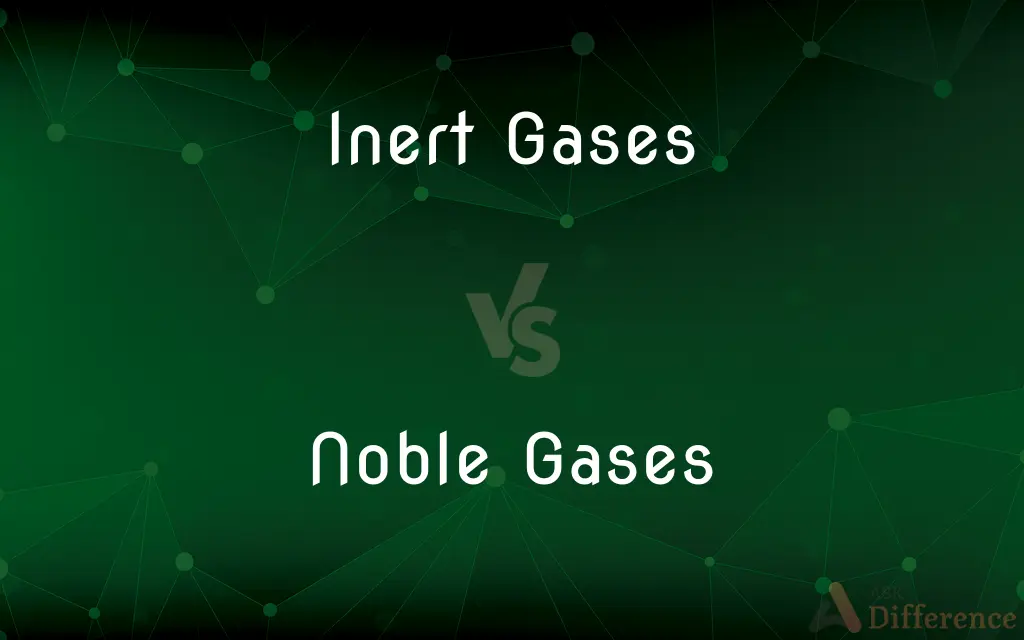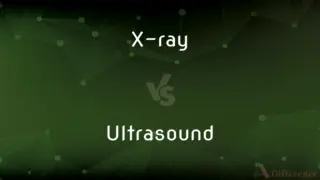Inert Gases vs. Noble Gases — What's the Difference?
By Tayyaba Rehman — Published on December 10, 2023
Inert Gases don't readily react with other elements; Noble Gases are a specific group of inert gases in the periodic table's Group 18.

Difference Between Inert Gases and Noble Gases
Table of Contents
ADVERTISEMENT
Key Differences
Inert Gases are gases that are typically unreactive and do not easily engage in chemical reactions with other substances. This unreactivity is due to various factors, but the most common reason is the complete electron configuration in their outer shell. Inert Gases can be found in various groups on the periodic table, not just in Group 18.
Noble Gases, on the other hand, refer specifically to the group of gases found in Group 18 of the periodic table. These gases include helium (He), neon (Ne), argon (Ar), krypton (Kr), xenon (Xe), and radon (Rn). All Noble Gases have a full valence shell, making them stable and less likely to form compounds with other elements.
It's essential to understand that while all Noble Gases are Inert Gases, not all Inert Gases are Noble Gases. This distinction lies in the specific grouping within the periodic table. Noble Gases, being a subset of Inert Gases, share the characteristic of being unreactive, but they have their unique position in the periodic table.
One might encounter Inert Gases outside of the Noble Gases group. For instance, nitrogen (N2) is often considered an inert gas under specific conditions, even though it's not a member of Group 18. Yet, when one refers to Noble Gases, they are strictly talking about the six gases in Group 18.
In conclusion, while both Inert Gases and Noble Gases share the trait of being largely unreactive, the term "Noble Gases" refers exclusively to the specific group of gases in Group 18 of the periodic table.
ADVERTISEMENT
Comparison Chart
Definition
Gases that are generally unreactive.
Gases found in Group 18 of the periodic table.
Examples
Can be from various groups (e.g., N2).
Helium (He), Neon (Ne), Argon (Ar), etc.
Reactivity
Don't readily react due to factors like full electron configuration.
Rarely react because of their full valence shell.
Position on Periodic Table
Not limited to any specific group.
Exclusively in Group 18.
Subsets
Includes Noble Gases as a subset.
Is a subset of Inert Gases.
Compare with Definitions
Inert Gases
Inert Gases are elements that resist reacting chemically.
Helium, one of the Inert Gases, doesn't burn or support combustion.
Noble Gases
Noble Gases possess full valence electron shells, making them stable.
Neon, a Noble Gas, is commonly used in glowing neon signs.
Inert Gases
Inert Gases are chemically stable due to their electron arrangements.
Due to their non-reactivity, Inert Gases are used in preserving historical documents.
Noble Gases
Noble Gases are known for their lack of color, odor, and flavor.
Radon, one of the Noble Gases, is radioactive and can be found in some basements.
Inert Gases
Inert Gases are often used in situations where reactivity is undesirable.
To prevent oxidation, Inert Gases are used in welding processes.
Noble Gases
Noble Gases rarely form compounds due to their full electron configurations.
Krypton, a Noble Gas, is sometimes used in high-performance window insulation.
Inert Gases
Inert Gases possess full electron configurations, causing their stability.
Argon is used in bulbs because, as an Inert Gas, it doesn't react with the filament.
Noble Gases
Noble Gases are unreactive gases in Group 18 of the periodic table.
Helium, one of the Noble Gases, is used to fill balloons.
Inert Gases
Inert Gases can be found beyond Group 18 of the periodic table.
Nitrogen, an Inert Gas, makes up about 78% of Earth's atmosphere.
Noble Gases
Noble Gases are a subset of the broader category of Inert Gases.
Argon, a Noble Gas, is used in double glazing to improve insulation.
Common Curiosities
Are there any compounds formed by Noble Gases?
It's rare, but under specific conditions, some Noble Gases, like xenon, can form compounds.
Are all Noble Gases also considered Inert Gases?
Yes, all Noble Gases are a subset of Inert Gases and are unreactive.
What makes Inert Gases unreactive?
Inert Gases are generally unreactive due to their full electron configurations.
What's the significance of using Inert Gases in specific industries?
Due to their non-reactivity, Inert Gases are used in processes where reactions with other substances can be harmful, such as in welding or preserving artifacts.
Why are Noble Gases specifically placed in Group 18?
Noble Gases are in Group 18 because they all have full valence electron shells, making them stable.
Why is helium, a Noble Gas, used in balloons?
Helium, being lighter than air and non-flammable, is safe and causes balloons to float.
Can Inert Gases be found outside of Group 18?
Yes, while all Noble Gases are Inert Gases, some Inert Gases, like nitrogen, are not in Group 18.
Is it correct to say nitrogen is a Noble Gas?
No, while nitrogen is often considered an inert gas under specific conditions, it's not a Noble Gas.
Are all Inert Gases safe for humans?
While many Inert Gases are non-toxic, they can still pose asphyxiation risks in high concentrations by displacing oxygen. Some, like radon (a Noble Gas), are radioactive and harmful.
What gives neon signs their distinctive glow?
The glow in neon signs comes from the electrical excitation of neon, a Noble Gas, inside the tubes.
How many Noble Gases are there in total?
There are six Noble Gases: helium, neon, argon, krypton, xenon, and radon.
Do all Inert Gases have a full valence electron shell?
Most Inert Gases have full electron configurations, but not all have full valence shells. For example, Noble Gases always have full valence shells.
Share Your Discovery

Previous Comparison
X-ray vs. Ultrasound
Next Comparison
EEPROM vs. EPROMAuthor Spotlight
Written by
Tayyaba RehmanTayyaba Rehman is a distinguished writer, currently serving as a primary contributor to askdifference.com. As a researcher in semantics and etymology, Tayyaba's passion for the complexity of languages and their distinctions has found a perfect home on the platform. Tayyaba delves into the intricacies of language, distinguishing between commonly confused words and phrases, thereby providing clarity for readers worldwide.
















































